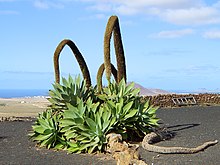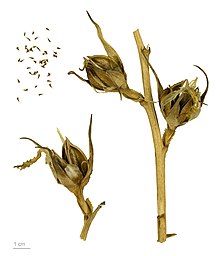
Agave parryi, known as Parry's agave or mescal agave, is a flowering plant in the family Asparagaceae, subfamily Agavoideae. It is a slow-growing succulent perennial native to Arizona, New Mexico, and northern Mexico.

Leuchtenbergia is a genus of cactus which has only one species, Leuchtenbergia principis. It is native to north-central Mexico. The genus is named after Maximilian Eugen Joseph (1817–1852), Duke of Leuchtenberg and amateur botanist.

Hoya carnosa, the porcelainflower or wax plant, is a species of flowering plant in the dogbane family Apocynaceae. It is one of the many species of Hoya that are native to Eastern Asia. It is a common house plant grown for its attractive waxy foliage, and sweetly scented flowers. It is grown well in pots and hanging baskets.

Gonialoe variegata, also known as tiger aloe and partridge-breasted aloe, is a species of flowering plant in the family Asphodelaceae. It is an evergreen succulent perennial indigenous to South Africa and Namibia. It is common in cultivation.

Aloe arborescens, the krantz aloe or candelabra aloe, is a species of flowering succulent perennial plant that belongs to the genus Aloe, which it shares with the well known and studied Aloe vera. The specific epithet arborescens means "tree-like". Aloe arborescens is valued by gardeners for its succulent green leaves, large vibrantly-colored flowers, winter blooming, and attraction for birds, bees, and butterflies.

Agave mitis is a plant species native to the Mexican states of Hidalgo, Tamaulipas and San Luis Potosí, referred to as Agave celsii in many publications.

Agave shawii is a species of monocarpic succulent plant in the genus Agave, commonly known as Shaw's agave. It is a rosette-forming plant characterized by glossy, green leaves with toothed margins. After several years of slow growth, the plant puts all of its resources to produce a towering stalk of flowers, and then dies. The death of the flowering rosette is compensated by the growth of numerous clonal pups. This species is segregated into two subspecies, one native to the coast of southwestern California and northwestern Baja California, known commonly as the coast agave, and another native to the Baja California desert, known as the Goldman agave.

Euphorbia misera is a semi-succulent shrub in the genus Euphorbia commonly known as the cliff spurge or coast spurge. A drought-deciduous shrub, it is typically found as a gnarled, straggly plant occupying seashore bluffs, hills and deserts. Like other members of its genus, it has a milky sap, which can be found exuding out of the light gray bark when damaged. The alternately-arranged leaves are round and folded in the middle, with small hairs on them. The "flowers" can be found blooming year-round, and are colored maroon or yellow in the center with 5 white to light-yellow petal-like appendages attached outside. This species is native to the Baja California peninsula and Sonora in Mexico, and the coast of southern California in the United States, where it is a rare species. It is threatened in some localities by the development of its coastal habitat, which tends to be prime locations for high-end residential and commercial developments.

Agave salmiana is a species of the family Asparagaceae, native to central and southern Mexico. It is also reportedly naturalized in South Africa, Italy and Spain, specially in the Canary Islands.

Agave is a genus of monocots native to the arid regions of the Americas. The genus is primarily known for its succulent and xerophytic species that typically form large rosettes of strong, fleshy leaves. Agave now includes species formerly placed in a number of other genera, such as Manfreda, ×Mangave, Polianthes and Prochnyanthes.

Agave parviflora is a species of succulent perennial flowering plant in the asparagus family, known by the common names Santa Cruz striped agave, smallflower century plant, and small-flower agave. It is native to Arizona in the United States and Sonora in Mexico.
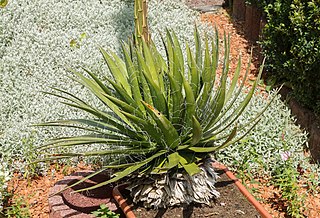
Agave filifera, the thread agave, is a species of flowering plant in the family Asparagaceae, native to Central Mexico from Querétaro to Mexico State. It is a small or medium-sized succulent plant that forms stemless rosette up to 3 feet (91 cm) across and up to 2 feet (61 cm) tall. The leaves are dark green to a bronzish-green in color and have very ornamental white bud imprints. The flower stalk is up to 11.5 feet (3.5 m) tall and is densely loaded with yellowish-green to dark purple flowers up to 2 inches (5.1 cm) long. Flowers appear in autumn and winter.

Dudleya attenuata is a species of perennial succulent plant known by the common name taper-tip liveforever, native to Baja California and a small portion of California. A rosette-forming leaf succulent, it has narrow pencil shaped leaves that can often be found covered in a white epicuticular wax. The thin, sprawling stems branch to form the clusters of rosettes, with plants creating a "clump" up to 40 cm wide. The small flowers are white or yellow, with 5 spreading petals. It is a diverse, variable species that extends from the southernmost coast of San Diego County to an area slightly north of the Vizcaino Desert, hybridizing with many other species of Dudleya in its range. Some plants with white or pinkish flowers were referred to as Orcutt's liveforever, referring to a former subspecies split on the basis of the flower color.
The Asparagales are an order of plants, and on this page the structure of the order is used according to the APG III system. The order takes its name from the family Asparagaceae and is placed in the monocots. The order is clearly circumscribed on the basis of DNA sequence analysis, but is difficult to define morphologically, since its members are structurally diverse. The APG III system is used in World Checklist of Selected Plant Families from the Royal Botanical Gardens at Kew. With this circumscription, the order consists of 14 families with approximately 1120 genera and 26000 species.

Aloe lomatophylloides is a unique species of Aloe endemic to the island of Rodrigues, in the Indian Ocean. It is part of a group of aloes which bear fleshy berries, and were therefore classed as a separate group, Aloe section Lomatophyllum.

Aloe macra is a species of Aloe endemic to the island of Réunion, in the Indian Ocean.
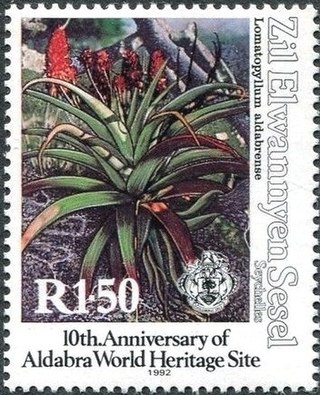
Aloe aldabrensis is a species of Aloe endemic to the islands of Aldabra in the Indian Ocean, where it can still be found in coastal scrub on limestone-based soil.
Aloe mayottensis is a species of Aloe indigenous to the island of Mayotte and surrounding islands of the Comoros, in the Indian Ocean. Formerly more widespread, it is now rarely found outside of cultivation.
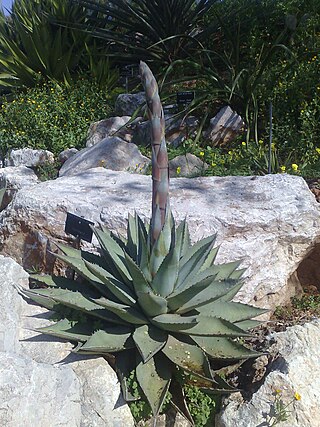
Agave margaritae is a species of plant from the Agave genus. Its common name in English is "Magdalena Island Agave".

Aloeae is a tribe of succulent plants in the subfamily Asphodeloideae of the family Asphodelaceae, consisting of the aloes and their close relatives. The taxon may also be treated as the subfamily Alooideae by those botanists who retain the narrower circumscription of Asphodelaceae adopted prior to the APG III system. Typically, plants have rosettes of more or less succulent leaves, with or without a distinct stem. Their flowers are arranged in racemes and tend to be either small and pale, pollinated by insects, or larger and more brightly coloured, pollinated by birds. As of 2017, 11 genera are recognized, most created since 2010 by splitting off another five genera from Aloe and another two from Haworthia. Only two genera, Aloe and Aloidendron, are native outside southern Africa, extending northwards to the Arabian Peninsula. Seven genera are restricted to South Africa, some with small ranges. Members of the Aloeae are cultivated by succulent plant enthusiasts; Aloe species especially are used in temperate climates as ornamental garden plants. Some species are used in traditional medicine. Aloe vera and Aloe ferox are cultivated for their extracts, whose uses include moisturizers and emollients in cosmetics.
